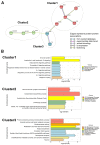Transcriptomics of Parental Care in the Hypothalamic-Septal Region of Female Zebra Finch Brain
- PMID: 35269661
- PMCID: PMC8910180
- DOI: 10.3390/ijms23052518
Transcriptomics of Parental Care in the Hypothalamic-Septal Region of Female Zebra Finch Brain
Abstract
(1) Background: The objective of this study was to uncover genomic causes of parental care. Since birds do not lactate and, therefore, do not show the gene expressional changes required for lactation, we investigate gene expression associated with parenting in caring and non-caring females in an avian species, the small passerine bird zebra finch (Taeniopygia guttata). Here, we compare expression patterns in the hypothalamic-septal region since, previously, we showed that this area is activated in parenting females. (2) Methods: Transcriptome sequencing was first applied in a dissected part of the zebra finch brain related to taking care of the nestlings as compared to a control group of social pairs without nestlings. (3) Results: We found genes differentially expressed between caring and non-caring females. When introducing a log2fold change threshold of 1.5, 13 annotated genes were significantly upregulated in breeding pairs, while 39 annotated genes were downregulated. Significant enrichments of dopamine and acetylcholine biosynthetic processes were identified among upregulated pathways, while pro-opiomelanocortin and thyroid hormone pathways were downregulated, suggesting the importance of these systems in parental care. Network analysis further suggested neuro-immunological changes in mothers. (4) Conclusions: The results confirm the roles of several hypothesized major pathways in parental care, whereas novel pathways are also proposed.
Keywords: RNA-Seq; gene expression; gene ontology; hypothalamic–septal region; parental care; posthatching period; social behaviour; transcriptome sequencing; zebra finch mother.
Conflict of interest statement
The authors declare no conflict of interest.
Figures






Similar articles
-
Neuronal activation in zebra finch parents associated with reintroduction of nestlings.J Comp Neurol. 2020 Feb 15;528(3):363-379. doi: 10.1002/cne.24761. Epub 2019 Aug 26. J Comp Neurol. 2020. PMID: 31423585
-
Genetic mapping of the major histocompatibility complex in the zebra finch (Taeniopygia guttata).Immunogenetics. 2011 Aug;63(8):523-30. doi: 10.1007/s00251-011-0525-9. Epub 2011 Apr 15. Immunogenetics. 2011. PMID: 21494955
-
Transcriptomic analysis of immune response to bacterial lipopolysaccharide in zebra finch (Taeniopygia guttata).BMC Genomics. 2019 Aug 14;20(1):647. doi: 10.1186/s12864-019-6016-3. BMC Genomics. 2019. PMID: 31412766 Free PMC article.
-
Brain Distribution and Sexually Dimorphic Expression of Amylin in Different Reproductive Stages of the Zebra Finch (Taeniopygia guttata) Suggest Roles of the Neuropeptide in Song Learning and Social Behaviour.Front Neurosci. 2020 Jan 13;13:1401. doi: 10.3389/fnins.2019.01401. eCollection 2019. Front Neurosci. 2020. PMID: 32009882 Free PMC article.
-
Neuroendocrine regulation of long-term pair maintenance in the monogamous zebra finch.Horm Behav. 2015 Nov;76:11-22. doi: 10.1016/j.yhbeh.2015.04.014. Epub 2015 Apr 29. Horm Behav. 2015. PMID: 25935729 Review.
Cited by
-
Recent advances in neuropeptide-related omics and gene editing: Spotlight on NPY and somatostatin and their roles in growth and food intake of fish.Front Endocrinol (Lausanne). 2022 Oct 4;13:1023842. doi: 10.3389/fendo.2022.1023842. eCollection 2022. Front Endocrinol (Lausanne). 2022. PMID: 36267563 Free PMC article. Review.
-
Identification of potential candidate genes and regulatory pathways related to reproductive capacity in hypothalamus and pituitarium of male ducks (Anas platyrhynchos) by differential transcriptome analysis.J Anim Sci. 2023 Jan 3;101:skac363. doi: 10.1093/jas/skac363. J Anim Sci. 2023. PMID: 36315611 Free PMC article.
References
-
- Driessen T.M., Eisinger B.E., Zhao C., Stevenson S.A., Saul M.C., Gammie S.C. Genes showing altered expression in the medial preoptic area in the highly social maternal phenotype are related to autism and other disorders with social deficits. BMC Neurosci. 2014;15:11. doi: 10.1186/1471-2202-15-11. - DOI - PMC - PubMed
MeSH terms
Grants and funding
- OTKA K134221/Hungarian National Research, Development and Innovation Office
- OTKA FK 131966/Hungarian National Research, Development and Innovation Office
- NKFIH-4300-1/2017-NKP_17/Hungarian National Research, Development and Innovation Office
- Eötvös Loránd University Thematic Excellence Programme 2020 (TKP2020-IKA-05)/Hungarian National Research, Development and Innovation Office
- János Bolyai Research Scholarship/Hungarian Academy of Sciences
LinkOut - more resources
Full Text Sources

